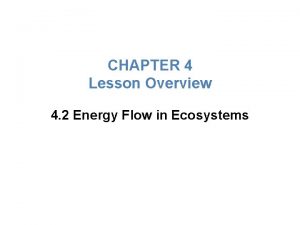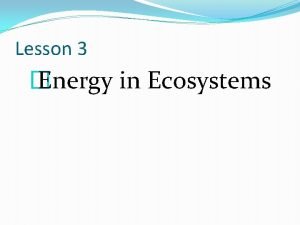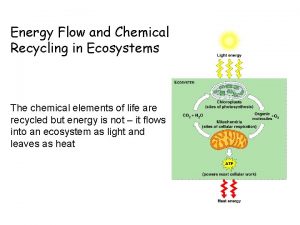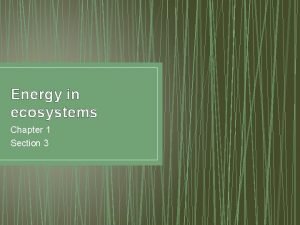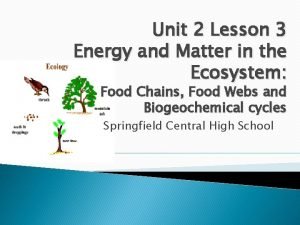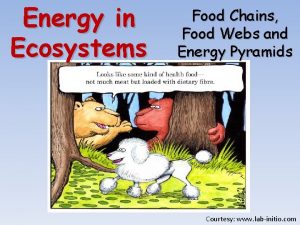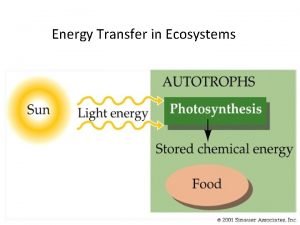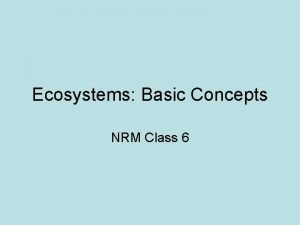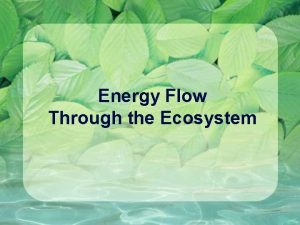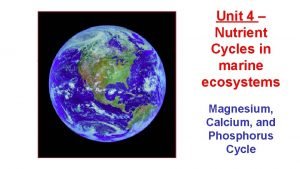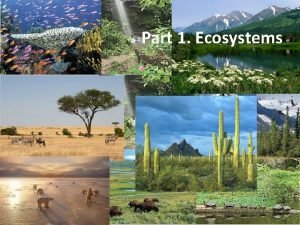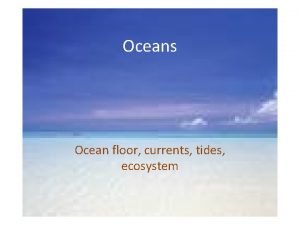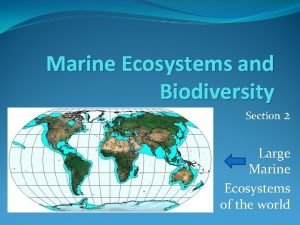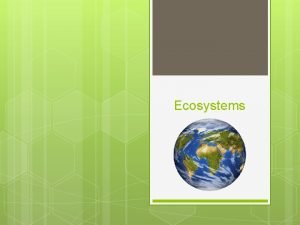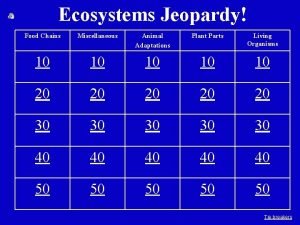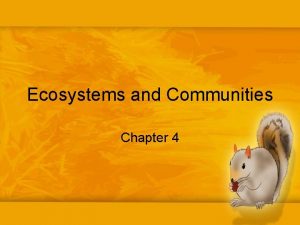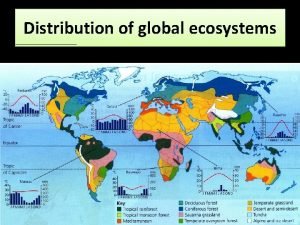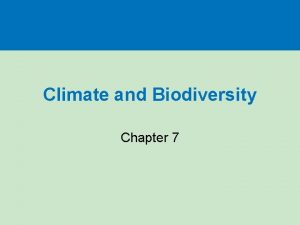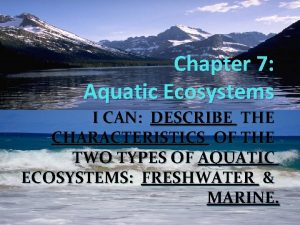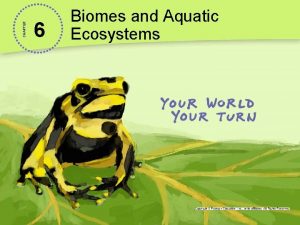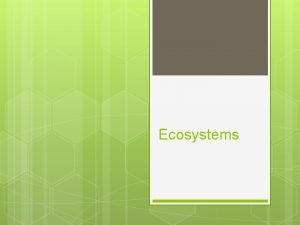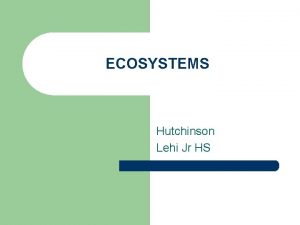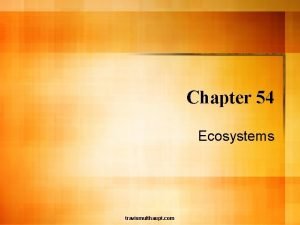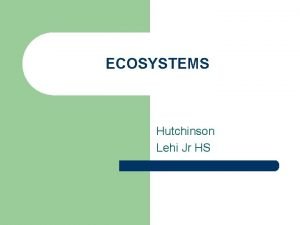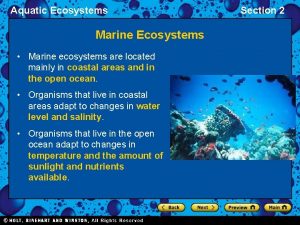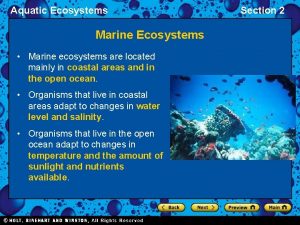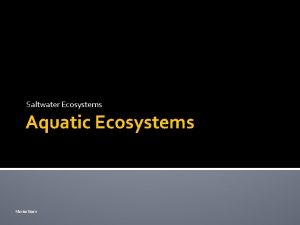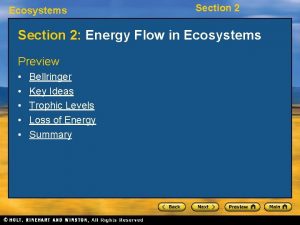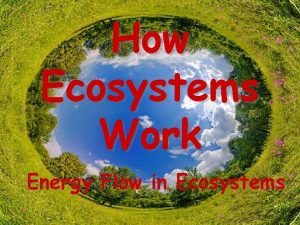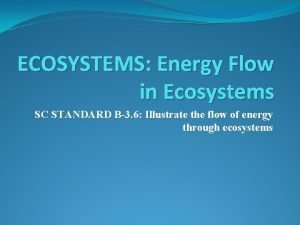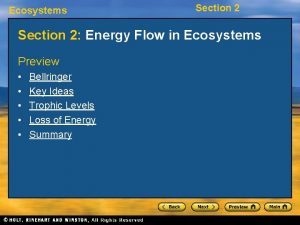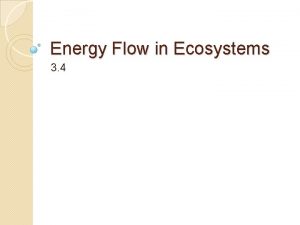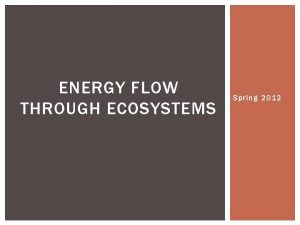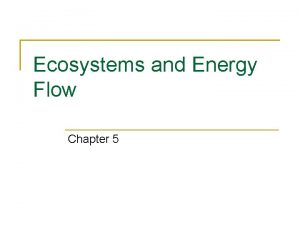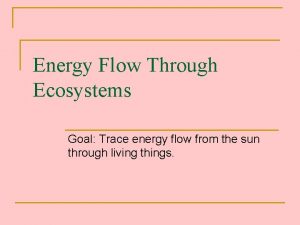Energy Flow in Ecosystems How does energy flow





































- Slides: 37

Energy Flow in Ecosystems

How does energy flow in an ecosystem? • Energy flow is the transfer of energy from one organism to another in an ecosystem. Every organism interacts with its ecosystem in two ways: • 1. the organism obtains food energy from the ecosystem • 2. the organism contributes energy to the ecosystem

How are energy flow and feeding relationships in ecosystems modelled? • Ecologists use three models to illustrate energy flow and feeding relationships in an ecosystem: • 1. Food chains: Food chains show the flow of energy from plant to animal and from animal to animal. • Plants are called producers because they “produce” food in the form of carbohydrates during photosynthesis. • Consumers eat plants and other organisms. • Each step in a food chain is called a trophic level.




Food webs • Many animals are part of more than one food chain in an ecosystem because they eat or are eaten by several organisms. • Interconnected food chains are illustrated in a model called a food web. • Animals that eat plants and other animals are called omnivores.


Food pyramids • A food pyramid (or ecological pyramid) is a model that shows the loss of energy from one trophic level to another. • When one organism consumes another, the energy stored in the food organism is transferred to the consumer. • However, not all of this energy is incorporated into the consumer’s tissues. Between 80 and 90 percent of it is used for chemical reactions and is lost as heat. • This means ecosystems can support fewer organisms at higher trophic levels, as less energy reaches these levels.






How do dead organisms contribute to energy flow? • Decomposition describes the breakdown of organic wastes and dead organisms. Energy is released in decomposition. • When living organisms carry out decomposition, it is called biodegradation. • Detrivores, such as small insects, earthworms, bacteria, and fungi, obtain energy and nutrients by eating dead plants and animals, as well as animal waste. • Decomposers, such as bacteria and fungi, change wastes and dead organisms into nutrients that can once again be used by plants and animals. • Detrivores and decomposers feed at every trophic level.

Nutrient Cycles in Ecosystems




How are nutrients cycled in the biosphere? • Nutrients are chemicals required for plant and animal growth and other life processes. They are constantly recycled within • Earth’s biosphere. • Nutrients spend different amounts of time in stores within the atmosphere, oceans, and land. • Nutrients are stored for short periods of time in short-term stores, such as living organisms and the atmosphere. • Nutrients can also be incorporated into longer-term stores, such as Earth’s crust. • Nutrient cycles describe the flow of nutrients in and out of stores as a result of biotic and abiotic processes. • There are three main cycles: • 1. the carbon cycle • 2. the nitrogen cycle • 3. the phosphorus cycle

How does the carbon cycle work? • Carbon is an essential component of cells and life-sustaining chemical reactions. • Carbon is cycled through living and decaying organisms, the atmosphere, bodies of water, and soil and rock.


Carbon moves between stores via six main processes: 1. Photosynthesis: Photosynthesis is a chemical reaction that converts solar energy and atmospheric carbon dioxide gas (CO 2) into chemical energy. 2. Cellular respiration: During cellular respiration, plants and animals obtain energy by converting carbohydrates and oxygen (O 2) into carbon dioxide and water. 3. Decomposition: Decomposers release carbon dioxide into the atmosphere through the decomposition of carbon-rich organic matter in soil. 4. Ocean processes: Dissolved carbon dioxide is stored in oceans. Marine organisms store carbon-rich carbonate (CO 3 2_) in their shells, which eventually form sedimentary rock. 5. Volcanic eruptions 6. Forest fires

How do human activities affect the carbon cycle? • Human activities, such as fossil fuel combustion and land clearance, quickly introduce carbon into the atmosphere from longer-term stores. • Increase the levels of carbon dioxide, a greenhouse gas that contributes to global climate change.

How does the nitrogen cycle work? • Nitrogen is an important component of DNA and proteins. • Most nitrogen is stored in the atmosphere, where it exists as nitrogen gas (N 2). It is also stored in bodies of water, living organisms, and decaying organic matter. • Most organisms cannot use atmospheric nitrogen gas.


The nitrogen cycle involves four processes, Three of which make nitrogen available to plants and animals: 1. Nitrogen fixation: Nitrogen gas is converted into nitrate (NO 3 -) and ammonium (NH 4 +), compounds that are usable by plants. Nitrogen fixation occurs mainly through nitrogen-fixing bacteria, and when lightning strikes in the atmosphere. 2. Nitrification: Ammonium is converted into nitrate and nitrite (NO 2–) through the work of nitrifying bacteria. 3. Uptake: Useable forms of nitrogen are taken up by plant roots and incorporated into plant proteins. When herbivores and omnivores eat plants, they incorporate nitrogen into their own tissues. 4. Denitrification: Denitrifying bacteria convert nitrate back into atmospheric nitrogen.


How do human activities affect the nitrogen cycle? • Fossil fuel combustion and burning organic matter release nitrogen into the atmosphere, where it forms acid rain. • Chemical fertilizers also contain nitrogen, which escapes into the atmosphere or leaches into lakes and streams. High levels of nitrogen cause eutrophication (too many nutrients) and increased algal growth in aquatic ecosystems, depriving aquatic organisms of sunlight and oxygen.

How does the phosphorus cycle work? • Phosphorus carries energy to cells. It is found in phosphate (PO 4 3 -) rock and sediments on the ocean floor. Weathering— through chemical or physical means—breaks down rock, releasing phosphate into the soil from longer-term stores. • Organisms take up phosphorus. When they die, decomposers return phosphorus to the soil. • Excess phosphorus settles on floors of lakes and oceans, eventually forming sedimentary rock. It remains trapped for millions of years until it is exposed through geologic uplift or mountain building.


How do human activities affect the phosphorus cycle? • Commercial fertilizers and phosphatecontaining detergents enter waterways and contribute additional phosphate to the phosphorus cycle. • Slash-and-burn forest clearance reduces phosphate levels, as phosphate in trees enters soil as ash. It leaches out of the soil and settles on lake and ocean bottoms, unavailable to organisms

Effects of Bioaccumulation on Ecosystems

How can pollutants affect food chains and ecosystems? • • • Human activity creates many harmful pollutants. These build up in the environment when decomposers are unable to break them down. Plants take up these pollutants. The pollutants are then transferred along the food chain until they reach the highest trophic level. Bioaccumulation refers to the gradual build-up of pollutants in living organisms. Biomagnification refers to the process in which pollutants not only accumulate, but also become more concentrated at each trophic level. Organisms at lower trophic levels may be affected by the pollutant, but primary, secondary, and tertiary consumers will be more affected, because levels will build up in their tissues as they consume contaminated food. An example of this is the PCB concentrations in the orca’s food web. When orcas consume food contaminated with PCBs, they store some of the PCBs in their blubber. When salmon (their primary food) is not available, orcas use their blubber for energy. This releases PCBs into their system. Pollutants can build up to toxic levels in organisms at the top of the food chain. They can also affect entire ecosystems when keystone species, species that greatly affect ecosystem health, or the reproductive abilities of species are harmed.

What are some human-made compounds that bioaccumulate and biomagnify? • PCBs (polychlorinated biphenyls) PCBs were once widely used in industrial products but are now banned in North America. They interfere with normal functioning of the body’s immune system and cause problems with reproduction. • PCBs have a long half-life (time it takes for the amount of a substance to decrease by half). They stay in the environment for a long time. Aquatic ecosystems are most sensitive to PCBs. Organisms at high trophic levels, like the orca, retain high levels of the pollutant. • POPs (persistent organic pollutants) • POPs are harmful, carbon-containing compounds that remain in water and soil for many years. DDT (dichloro-diphenyl-trichloroethane) is a toxic POP that was used as a pesticide in the past to control disease carrying mosquitoes. • Accumulation is measured in parts per million (ppm). This refers to one particle of a given substance mixed with 999 other particles. DDT is harmful at 5 ppm.

Heavy metals • Once heavy metals enter the biosphere, they do not degrade, and they can not be destroyed. • Heavy metals, such as lead (Pb), cadmium (Cd), and mercury (Hg), are toxic at low concentrations; however, small amounts are naturally present in soil. • For humans, the most serious source of cadmium poisoning is smoking. • Human activities can cause these metals to build up in ecosystems. • In the past, use of lead-based insecticides, batteries, and paints, increased lead to harmful levels. • Despite reductions, lead still enters ecosystems through improperly disposed electronic waste.

How can the effects of chemical pollution be reduced? • Some harmful chemical pollutants can be removed from the environment by bioremediation, a process where microorganisms or plants help clean them up. • Reacting contaminants with certain chemicals can also make them less harmful.
 Chapter 4 lesson 2 energy flow in ecosystems
Chapter 4 lesson 2 energy flow in ecosystems Energy in ecosystems lesson 3 answer key
Energy in ecosystems lesson 3 answer key Energy flow and chemical recycling in ecosystems
Energy flow and chemical recycling in ecosystems Lesson 4: energy flow in ecosystems
Lesson 4: energy flow in ecosystems Section 1 energy flow in ecosystems
Section 1 energy flow in ecosystems Do birds eat squirrels
Do birds eat squirrels Section 3 energy in ecosystems
Section 3 energy in ecosystems Chapter 42 ecosystems and energy
Chapter 42 ecosystems and energy How does energy flow in an ecosystem
How does energy flow in an ecosystem Phosphorus cycle
Phosphorus cycle Lab food chains and energy in ecosystems
Lab food chains and energy in ecosystems Energy flow through an ecosystem is ----- *
Energy flow through an ecosystem is ----- * Ecosystem definition class 6
Ecosystem definition class 6 Flow energy review
Flow energy review Oikos meaning
Oikos meaning Difference between conduction convection and radiation
Difference between conduction convection and radiation How does energy flow through an ecosystem
How does energy flow through an ecosystem Energy flow trophic levels
Energy flow trophic levels How does energy flow through an ecosystem
How does energy flow through an ecosystem River pollution introduction
River pollution introduction Magnesium cycle in marine ecosystem
Magnesium cycle in marine ecosystem Lesson outline lesson 2 aquatic ecosystems answer key
Lesson outline lesson 2 aquatic ecosystems answer key Chapter 3 section 3 aquatic ecosystems
Chapter 3 section 3 aquatic ecosystems Ecosystems examples
Ecosystems examples The ecosystems
The ecosystems Most amazing ecosystems
Most amazing ecosystems Ecosystems examples
Ecosystems examples Interactions in the environment grade 7
Interactions in the environment grade 7 Biomes title page
Biomes title page Ecosystems title page
Ecosystems title page Food chain jeopardy
Food chain jeopardy Chapter 4 ecosystems and communities
Chapter 4 ecosystems and communities Distribution of global ecosystems
Distribution of global ecosystems Human impact on terrestrial ecosystems
Human impact on terrestrial ecosystems Marine ecosystem webquest
Marine ecosystem webquest Savanna biome plants
Savanna biome plants 3 aquatic biomes
3 aquatic biomes Chapter 55 ecosystems and restoration ecology
Chapter 55 ecosystems and restoration ecology
